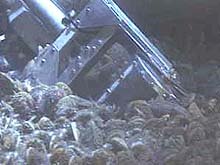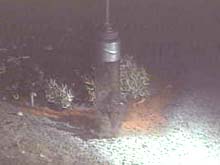
The Johnson Sea Link II manned submersible is equipped with a moveable arm and an attached scoop to facilitate the collection of mussels and other organisms.
Working at the Brine Pool
Student Report
February 16, 2003
Ahna VanGaest, Undergraduate Student
Oregon Institute of Marine Biology
University of Oregon
Shortly after the sun rose over the Gulf of Mexico, the Johnson Sea-Link II submersible descended for another dive. The seas were calm as the immense A-frame on the back of the NOAA Research Vessel Seward Johnson lowered the submersible into the ocean. The submersible and its crew descended to 2,020 ft below the surface, where we unknowingly reached the sea floor 700 m away from our destination, the Brine Pool. We propelled our way across the seemingly desolate sea floor, where only a few pale fishes swam, until we encountered the Brine Pool, an oasis of life. The Brine Pool is an underwater lake filled with very salty, methane-enriched brine and surrounded by mussel beds several meters across. The mussel beds teemed with life, including large spider crabs, smaller galatheid crabs, snails, and bright red polychaete worms that crawled and swam around the mussels.
Although the sightseeing was incredible, we were there for a greater purpose: science. Our first objective was to deploy six settlement racks for juvenile mussels (Bathymodiolus childressi) across the mussel bed with the arm of the submersible. When this was done, we picked up several tubes of embryos that were fertilized on the ship and brought them down to depth to develop. Our final objective was to collect a bucketful of mussels to take home to our lab in Charleston, Oregon.
The seas above us were getting rough, so with no time to waste, we began our ascent to the surface. The lights of the submersible were turned off and the control panels covered, so that in complete darkness, we saw the most spectacular natural display of fireworks. Bioluminescent bacteria, algae, copepods, fishes, and jellyfish lit up the entire view in green flashes and squirts. At 1,350 ft below the surface, sunlight began to filter through, slowly illuminating the equipment. Twenty minutes after we had left the Brine Pool, we found ourselves bobbing on the surface waiting for the ship to pick us up. What an incredible journey!

This coring device was pressed into a red bacterial mat, which covered the sediment surface and surrounded a patch of tubeworms. Erich Fleming, a doctoral student at the University of Oregon, will process the cores and use them to study bacterial diversity in the deep sea.
More Work at the Brine Pool
Student Report
February 16, 2003
Jessica A. Miller, Doctoral Candidate
Oregon Institute of Marine Biology
University of Oregon
The relatively high winds (20 knots) and large swells have prevented the Johnson Sea-Link II submersible from diving for the last two days. Ahna VanGaest and I are the only two students in Craig Young's deep-sea biology class who have yet to descend to the ocean floor during this cruise. The decision was made to try to launch today at 7 am, instead of the usual 8 am, in an effort to complete a quick dive before the winds and waves increased. We launched at 7:31 am with a number of goals. Our initial task was to place trays of juvenile mussels (Bathymodiolus childressi) on the ocean floor within and around the mussel bed at the Brine Pool to estimate juvenile predation. Secondly, we planned to recover embryos of the mussel and the beautiful giant fileshell clam (Acesta bullisi).
A few days earlier, in the ship's laboratory, researchers had extracted sperm and eggs from adults of these two species collected from the Brine Pool that day. Plastic tubes of embryos were then taken back down to the Brine Pool in hopes that embryonic development would continue normally at depth and the researchers would be able to document their embryological development. Finally, we needed to collect adult mussels of B. childressi for transport to the Oregon Institute of Marine Biology for further research. As the submersible descended about 100 ft/min, I found myself wishing we could slow down, particularly in the darker regions deeper than 700 ft, where the reduced light enhanced the bioluminescent creatures inhabiting the water column. I sat in the rear compartment of the submersible, where there are two small portholes for viewing. I was able to watch what occurs in front of the submersible through a video monitor.
Once we arrived at the Brine Pool, I watched the submersible's hydraulic arm and shovel deploy the predation experiments, recover the embryos, and dig up some mussels to take to the surface. When I looked out my porthole, I saw a bright pinkish-orange anglerfish resting in the sediment and a few eels swimming in the Brine Pool. We quickly finished our tasks and headed for the surface at 9:06 am. We ascended quickly, about 150 ft/min, because the weather at the surface was getting rough. Although I gathered from reports when we got back to the surface that it was a rough recovery, I am very grateful to have been part of this dive, since it turned out to be the last one of the cruise.
In the afternoon, Dr. Young lectured on barophysiology (adaptations to the high pressures found in the deep sea) and the hydrodynamics of filter and deposit feeding. The rest of the afternoon was filled with student projects and efforts to organize and clean the wet laboratory. The student projects were diverse and involved a variety of organisms found along cold seeps, including the examination of the osmoregulatory capability of an orbinid worm, the temperature tolerance of adult mussels, and the ability of galatheid crabs to adapt to low oxygen levels. Many ideas and interests have been kindled over the last 10 days. So much is unknown about the organisms of the deep sea; it was captivating to witness how research can be accomplished at such depths.
In the evening, we enjoyed a lobster dinner followed by a group discussion on waste disposal in the ocean and the exploitation of ocean resources. Both of these intriguing topics are difficult to get a handle on because so little is definitively known about the consequences of such activities. The ocean swells grew as the night progressed, and sleep eluded many of us. Some remained on the bridge to learn more about the ins and outs of navigation and to view the vast Gulf of Mexico from yet another vantage point.









